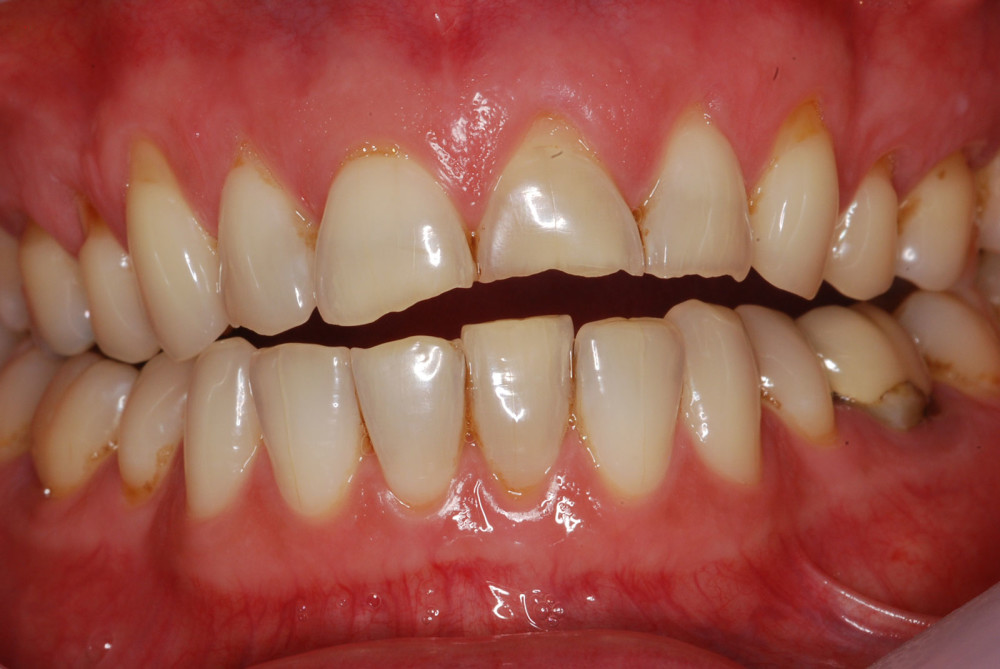Treatment of worn teeth
Why do teeth wear and breakdown?
Worn teeth are increasingly common these days, especially in younger people, yet they can be prevented and treated once the cause is identified. Teeth are comprised of dentine and enamel, 2 mineralized structures that do not regenerate. Enamel is the hardest substance produced in the animal world; it is highly mineralized and crystalline in structure, whereas the underlying dentine has a more bone-like quality and it is nourished by the tissues of the pulp of the tooth. As teeth age, more dentine is created from within the tooth. This is one of the reasons why teeth change colour with age; they become less white, and less sensitive to temperature.
Some wear to teeth is a natural side effect of ageing, with worn teeth becoming smaller and darker in colour. This is mainly an aesthetic problem, unless it starts to affect your bite and function, such as your ability to chew your food.
What Is “Normal” Wear?

Excessive tooth surface loss
Because there are no clear guidelines for what constitutes “normal†wear, it is generally and broadly defined as that which should be equal in rate or speed with ageing. It is common for the teeth to show some wear with age, but the system will naturally compensate for it. As teeth wear they will move minutely, by erupting slightly, moving to maintain proper biting relations. They will also move or drift toward the front of the mouth and tend to crowd more with age. The process is gradual over a very long time. It is when wear becomes excessive, beyond what the body can compensate for through the natural eruption of teeth, that problems arise leading to changes in bite relationships and loss of facial height.
Many factors can cause your teeth to wear, that is why the correct term is “Tooth Surface Loss” (TSL). In order to prevent and possibly treat the effects of TSL it is vital to understand the causes of the nature of TSL in each particular individual. As discussed, TSL may be physiological, and may have occurred as a natural consequence of ageing. The forms of accelerated tooth surface loss that result in worn down teeth are:
Attrition
This is tooth-to-tooth wear on the biting edges of the teeth caused by excessive grinding or clenching, also called bruxism. Bruxism is the involuntary tooth grinding or clenching, usually done during sleep. Whereas normal forces (13-23 pounds) are applied to the teeth, during function such as biting, parafunctional forces of a much greater magnitude are applied during sleep by people who grind their teeth. It’s not just the large forces generated, but their direction, duration and frequency together that are so damaging. Studies have shown that the majority of people who grind are not aware of this destructive habit. Highly destabilizing forces applied both frequently and for long periods can lead to problems, symptoms and breakdown.
They can stress:
The muscles — causing spasm and pain; people who grind mat experience frequent headaches.
The jaw joints — causing TMD (Temporo-Mandibular Disorder)
The periodontal ligaments (attach teeth to bone) — causing tooth looseness or;
The teeth — causing excessive wear or even fractures.
Combinations of some or all of these factors can also occur.
Excessive tooth surface loss cannot be readily maintained by the normal compensation of tooth eruption and the effects can be profound.
Excessive wear can also lead to “bite collapse,” with associated facial changes that produce sagging cheeks, and creasing of the lips at the corners of the mouth — all manifestations of lessening lower face height which accentuate the aging process. Teeth may also become sensitive to cold.

Abrasion
This is tooth wear through over aggressive brushing and typically affects the sides and necks of the teeth. Hard bristled toothbrushes and wrong brushing technique are the main reasons for this type of TSL.
Erosion
This is loss of tooth structure (enamel and dentine) dissolved through acid erosion caused by acidic foods and drinks in our diets, or in patients with conditions like bulimia or acid-reflux. Some people will have more than one of these factors, sometimes even all three. Almost all fizzy and sports drinks have a high acidity and may lead to TSL.
Oral Habits
Parafunctional forces can also impact the teeth through other habits. Tooth-to-foreign body habits encompass a broad range of objects that individuals habitually hold between their teeth like nails, pencils, bobby pins and more, that can create damage and wear. They can both move teeth and cause abnormal wear patterns.
Treatment for worn teeth
We can help to restore your worn or eroded teeth and treat them to prevent further damage – giving you optimum dental health, function and aesthetics. In addition to customised mouth appliances to improve and realign your bite, treatment offered for worn down teeth includes composite resin bonding, veneers, and crowns. It is very important to restore worn teeth in the most natural and conservative way without doing any further damage. Adhesive dentistry with the use of composites and ceramic materials offers this possibility.

Restoring a tooth with an adhesive metal-free onlay
As in most areas of medicine, treating a problem means getting to the root of its cause in order for treatment to be effective. With tooth surface loss it is not only necessary to replace the tooth structure lost through wear, but also to make sure that the corrected bite is properly restored in terms of form, function, normal tooth shapes and aesthetics. Once corrected, a properly aligned and functional bite should be maintained into the future with proper after care. One of the most important aspects of long-term maintenance and after care is the fabrication and use of a professionally made hard mouthguard (occlusal guard) during periods of stress or sleep that is specifically designed to protect the teeth when the damaging activity typically occurs. This simple step can result in improved oral health and social/psychological well-being.

Can you make my teeth look normal again without grinding them?
There are different ways of restoring your worn teeth. The various options, along with the pros and cons, will be presented to you after the initial diagnostic phase of planning. It is possible nowadays to restore teeth with TSL by bonding white fillings or composites. The technique is very conservative but also requires a significant amount of maintenance. The major advantage is that it is not necessary to remove further tooth structure as worn teeth are usually weak. Composite resins are able to restore the shape and function of a tooth by allowing the dentist to chemically bond the material, layer by layer onto the worn or broken tooth. All this can be achieved while the patient sits in the chair in one or several appointments, depending on how many teeth require restoration. Most of the time no local anaesthetic is required, hence no needles. The results show that patients can smile and eat with confidence, without the need to have expensive and invasive treatment. Very conservative porcelain veneers can also be used for restoring worn teeth without the need for significant tooth reduction.
You may preview the treatment of some cases with worn teeth in the iSmile Gallery section. You may arrange for a consultation appointment so we can plan your tooth restoration together.








